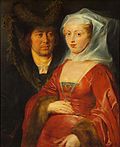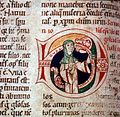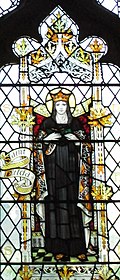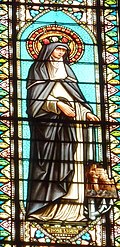List of 999 women of the Heritage Floor / Hrotsvit
This list describes the place settings for Hrotsvit on the table of Judy Chicago's art installation The Dinner Party . It is part of the list of 999 women on the Heritage Floor who are assigned to the respective place settings on the table. The names of the 999 women are on the tiles of the Heritage Floor, which is arranged below the table and belongs to the art installation.
description
The installation consists of a three-sided table, each with 13 historical or mythological personalities, thus a total of 39 people, from prehistory to the women's rights movement . These people were assigned a place setting at the table, consisting of an individually designed table runner, an individually designed plate, a goblet, knife, fork, spoon and serviette. The first page of the table is devoted to prehistory up to the Roman Empire , the second to Christianization up to the Reformation and the third from the American Revolution to the women's movement. Each place setting on the table is assigned additional personalities who have received an entry on the tiles of the Heritage Floor, which occupies the space under the table and the center of the space between the sides of the table. This list includes the personalities assigned to the Hrotsvit table setting. Your seat is on the second side of the table.
Hints
In addition to the names as they are used in German transcription or in scientific usage, the list shows the spelling chosen by Judy Chicago on the tiles.
The information on women who do not yet have an article in the German-language Wikipedia is referenced by the individual references listed under comments . If individual information in the table is not referenced via the main article, additional individual references are given at the relevant point. If there are any discrepancies between the information provided in Wikipedia articles and the descriptions of the work of art on the Brooklyn Museum website , this will also be indicated under Comments.
Place setting for Hrotsvit

Hrotsvit , also known as Hrotsvit von Gandersheim , born around 935, was a canon of the Gandersheim monastery . Presumably still young, she entered Gandersheim Abbey. She was taught there, as she reported, by Rikkardis and Gerberga , daughter of Duke Heinrich of Bavaria and niece of Otto the Great , who was abbess of the monasteryfrom 949. Her works were written between about 950 and 970. Her education was very extensive, including knowledge of some ancient writers. Her works are attributed to the " Ottonian Renaissance ".
As a Sanctimoniale and author of the early Middle Ages , she is considered the first German poet . In addition to spiritual writings, she wrote historical poems and the first dramas since ancient times were written . Her well-known works include Gesta Ottonis ( Gesta Oddonis; 'Die Taten Otto'), a work written in Latin hexameters on the family history and political work of Otto the Great, which she admired. Presumably she died after 973.
Hrotsvit herself divided her work into three books. The book of legends or carmina (liber primus) , created in the 50s and 60s of the 10th century, is dedicated to her abbess Gerberga, the book of drama or dramatica series (liber secundus), created around 965, wanted to offer a Christian alternative to Terence and that third book includes two historical writings in Leonine hexameters : the Gesta Ottonis (Gesta Oddonis), a story of the Ottonians from the years 919 to 965, and the Primordia coenobii Gandeshemensis, a story of the Gandersheim monastery from the years 846 to 919.
Your table setting at the dinner table tells of your life using pictures from medieval abbeys. The plate is illustrated by a stylized headdress and the hands of a nun folded in prayer. It is located in a relief that refers to ivory carvings from the Ottonian dynasty and is intended to indicate the social origins and religious life of Hrotsvit. The table runner takes up the topic and pays tribute to her contribution to literature. The runner was sewn using the Opus Teutonicum technique . On the front of the runner there are circles that resemble coins, as they were made by abbesses, who often also had the right to mint. The four circles depict scenes from early German history. A household scene, once a story is told, a princess from the Zimbri tribe with the head of an enemy soldier and a valkyrie . The initial “H” on the front is adorned with a portrait of Hrotsvit with a quill pen, as a tribute to her work as a writer. On the back of the runner there are three embroidered scenes from the life of Hrotsvit. They also represent the activities of medieval nuns. The first shows them entering an abbey where two nuns are singing. It shows the kind of education women received in the monasteries. The second picture shows Hrotsvit as a writer while her abbess watches and in the third picture she sleeps at her desk and dreams of a visit from a royal messenger who would give her a relic in recognition of her literary work.
| Surname | Spelling on the tile | Date of birth | cultural spatial assignment | Remarks | image |
|---|---|---|---|---|---|
| Æbbe | Ebba | 9th century | Scotland | Abbess of Coldingham Priory in south east Scotland. To avoid being raped in a robbery with their nuns, the women cut off their nose and upper lip. |

|
| Æthelburg | Ethelberga | 605 | Northumbria | Her marriage to Edwin marked the beginning of the conversion of the pagan north of England to Christianity. | |
| Æthelwynn | Ethylwyn | 10th century | England | A tenth century noblewoman known for her embroidery and her encounter with Saint Dunstan. | |
| Agnes II of Meissen | Agnes | before 1145 | Eastern Franconia , Quedlinburg Abbey | Abbess of the women's monastery in Quedlinburg , known for her fine handicrafts and weaving as well as handwritten illustrations. Agnes promoted artistic creation and supported an art industry with the work of her canonesses. |

|
| Aisha bint Ahmad al-Qurtubiya | Aisha | 10th century | Caliphate of Cordoba | Spanish poet who presented her work at the Royal Academy of Cordoba . | |
| Athanasia of Aegina | Athanarsa | about 790 | Byzantine Empire | Saints known for their miraculous healing of the sick and those seen as possessed. For a time she was an advisor to Empress Theodora II. | |
| Baudonivia | Baudonivia | 7th century | Frankish Empire | Nun of the Abbey of the Holy Cross and scholar who wrote the life story of Radegundis around 612 . | |
| Begga | Begga | around 620 | Frankish Empire | Saints from Austrasia , Andenne , Herstal , Landen , Brabant and Metz , founded the Andenne monastery on the Meuse between Namur and Liège in 690/691 . |

|
| Bertha | Bertha of France | 775 | Frankish Empire | Daughter of Charlemagne and Hildegard from Swabia, was expelled from the court by her brother, Emperor Ludwig the Pious , after the death of her father in 814 because of her way of life. | |
| Berthild of Chelles | Bertille | unknown; † 692 | Frankish Empire | First abbess of Chelles Abbey from 646. Her reputation drew several foreign princesses to the abbey, including Queen Bathildis. | |
| Bathilde | Berthildis | around 630 | Frankish Empire | Wife of the Franconian Merovingian king Clovis II of Neustria |

|
| Bertrada the Younger | Bertha | at 725 | Frankish Empire | In 741 she became the wife of the Frankish King Pippins the Younger († 768), around 747 the mother of Charlemagne . |

|
| Claricia | Claricia | 13th century | Holy Roman Empire , southern Germany | Illuminator of the 13th century. |

|
| Lady Carcas | Carcas | N / A | Frankish Empire | Legendary Saracen princess who led the army of Carcas and saved the city by deceiving Charlemagne's troops in Carcas into believing that the siege of the city would have had no effect on supplies. | |
| Dhuoda | Dhuoda | at 802 | Frankish Empire | At the behest of her husband Bernhard of Septimania , who mostly stayed in Aachen at the Carolingian court, she resided in Uzès, where she administered the possessions of Bernhard in his name and financed her husband's military operations. She wrote a manual for her son Wilhelm , the liber manualis . | |
| Diemut von Wessobrunn | Diemud | around 1060 | Duchy of Bavaria | Consecrated virgin, advertiser and book illustrator . | |
| Eadburh | Eadburga | 8th century | Kingdom of Wessex | Queen of the Anglo-Saxon Kingdom of Wessex. | |
| Eanswith | Eanswith | at 614 | England | Anglo-Saxon princess. In 630 Eanswith founded the Benedictine Folkestone Priory, the first nunnery in England. | |
| Elsbeth Stagel | Elizabeth Stagel | around 1300 | Winterthur | Nun and later prioress of the Dominican convent in Töss . |

|
| The End | The End | N / A | Kingdom of León | Manuscript illuminator who worked on a 10th century manuscript group of which there are 24 known copies with illustrations. These manuscripts contain the commentary by the Spanish monk Beatus de Liébana from the year 786. Your signature appears in the Beatus, now in Girona Cathedral , known as Girona Beatus. |

|
| Mrs. Ava | Mrs. Ava | around 1060 | Wachau | The first German-speaking poet known by name. | |
| Gertrud von Nivelles | Gertrude of Nivelles | 626 | Franconian Empire , Nivelles Monastery | Abbess of the Augustinian convent Nivelles in Belgium , is venerated as a virgin and saint in the Roman Catholic Church . |

|
| Gisela Abbess of Chelles | Gisela | 757 | Frankish Empire | Gisela, daughter of Pippin the Younger and sister of Charlemagne , was abbess of Chelles Abbey from 800 to 810 . | |
| Gisela von Kerssenbrock | Gisela of Kerzenbroeck | around 1250 | Frankish Empire , Rulle Monastery | Cistercian nun in the monastery of Rulle . She worked there as an illuminator , calligrapher and choir master. |

|
| Gormflaith ingen Murchada | Gormlaith | 960 | Ireland | Gormlaith was the third of Brian Boru's four wives . After this had captured Gormlaith, she sought the support of the Danes and the battle of Clontarf came , in which Brian Boru died and the High Kingdom was ended by Brian Boru. Gormlaith survived the battle and died 16 years later. | |
| Guda | Guda | 12th century | Holy Roman Empire | 12th century nun and illuminator. She signed her work and included a self-portrait. |

|
| Herlindis | Hardlind | 7th century | Franconian Empire , Maaseik | Holy and Benedictine abbess. She and her sister Relindis von Maaseik created an illuminated manuscript of the Christian Gospels. |

|
| Hilda of Whitby | Hilda of Whitby | 614 | England | Monastery founder. She is venerated as a saint . |

|
| Hygeburg | Hygeburg | at 730 to 740 | Frankish Empire | Nun in the wake of St. Walburga . She wrote the lives of St. Willibald von Eichstätt and St. Wunibald , from whose family she came. |

|
| Johanna von Lahde | Joanna | 12th century | Holy Roman Empire , Lahde Monastery | Prioress in Lahde Monastery , under whose direction tapestries were made. | |
| Leela of Granada | Leela of Granada | 13th century | Granada | Moorish scholars known for their erudition. | |
| Liadain | Liadain | 7th century | Ireland | Poet who, according to a story from the 9th century, lived in the 7th century and who is said to have had an unhappy romance with the poet Cuirithir mac Doborchu. Before they could find each other, Liadain took the vows of a nun and Cuirithir became a monk. They tried to build a friendship, however Cuirithir fled and Liadain died of a broken heart. Some scholars believe that the characters Liadan and Cuirithir are based on historical figures of the seventh century. | |
| Lioba from Tauberbischofsheim | Lioba | at 700/710 | Kingdom of Wessex , Frankish Empire | Missionary and Benedictine , is venerated in the Catholic Church as a virgin and saint . |

|
| Lubna of Cordoba | Libana | 2nd half of the 10th century | Andalusia | Intellectuals, famous for their knowledge of grammar and the quality of their poetry. | |
| Mabel of Bury St. Edmunds | Mabel | 13th century | England | Bury St Edmunds embroiderer of great skill. | |
| Mariam bint Abu Ya'qub Ashshilbi | Maria Alphaizuli | 8th century | Andalusia | Poet from Al-Andalus , some copies of her work survive in the library of the Real Sitio de San Lorenzo de El Escorial . | |
| Mariam bint Abu Ya'qub Ashshilbi | Maryann | 8th century | Andalusia | Poet from Al-Andalus, some copies of her work survive in the library of the Real Sitio de San Lorenzo de El Escorial | |
| Mathilde | Mathilda | around 955 | Franconian Empire , Quedlinburg | First abbess on the Stiftsberg in Quedlinburg . She is venerated as a blessed , especially in the diocese of Magdeburg . | |
| Relindis | Reinhild | 7th century | Franconian Empire , Maaseik | Holy and Benedictine abbess. She and her sister Herlindis von Maaseik created an illuminated manuscript of the Christian Gospels. | |
| Thoma | Thoma | 11th century | Caliphate of Cordoba | Legal scholar and author. | |
| Uallach ingen Muinecháin | Lady Uallach | unknown, † 934 | Ireland | Poet from the Dingle Peninsula in County Kerry . | |
| Wallada bint al-Mustakfi | Valada | 1001 | Caliphate of Cordoba | Poet in Cordoba's golden age under Islamic rule. She ran a lively literary salon. A great legacy after her father's death enabled her to live independently and disregard many of the conventions imposed on women of her time. She composed satirical, often caustic verses, a large part of which was dedicated to her lover, the poet Ibn Zaydún . |
- Individual evidence
- ↑ Brooklyn Museum: Hrosvitha. In: brooklynmuseum.org. Retrieved October 20, 2019 .
- ↑ Peter Clemoes, Michael Lapidge: Anglo-Saxon England: . Cambridge University Press, 1986, ISBN 978-0-521-33203-3 , pp. 89 ( books.google.de ).
- ↑ Brooklyn Museum: Aisha. In: brooklynmuseum.org. Retrieved September 22, 2019 .
- ^ Brooklyn Museum: Baudonivia. In: brooklynmuseum.org. Retrieved October 20, 2019 .
- ↑ Brooklyn Museum: Bertille. In: brooklynmuseum.org. Retrieved October 20, 2019 .
- ↑ Brooklyn Museum: Carcas. In: brooklynmuseum.org. Retrieved October 20, 2019 .
- ↑ Brooklyn Museum: Eadburga. In: brooklynmuseum.org. Retrieved October 20, 2019 .
- ^ Brooklyn Museum: Eanswith. In: brooklynmuseum.org. Retrieved October 20, 2019 .
- ↑ Brooklyn Museum: End. In: brooklynmuseum.org. Retrieved October 20, 2019 .
- ^ Brooklyn Museum: Gisela. In: brooklynmuseum.org. Retrieved October 20, 2019 .
- ↑ Brooklyn Museum: Gormlaith. In: brooklynmuseum.org. Retrieved December 8, 2019 .
- ^ Brooklyn Museum: Guda. In: brooklynmuseum.org. Retrieved October 20, 2019 .
- ↑ Brooklyn Museum: Hardlind. In: brooklynmuseum.org. Retrieved October 20, 2019 .
- ↑ Brooklyn Museum: Hygeburg. In: brooklynmuseum.org. Retrieved October 20, 2019 .
- ↑ Lemgo, Stift St. Marien, embroidered tapestry with the: German inscriptions online. In: inschriften.net. Retrieved October 20, 2019 .
- ^ Judy Chicago: The Dinner Party: Restoring Women to History . The Monacelli Press, LLC, 2014, ISBN 978-1-58093-397-1 ( books.google.de ).
- ↑ Brooklyn Museum: Liadain. In: brooklynmuseum.org. Retrieved October 20, 2019 .
- ↑ This Muslim woman Was Born a Spanish Slave, Then Became a Royal Advisor. In: mvslim.com. 2017, Retrieved October 20, 2019 (American English).
- ↑ Brooklyn Museum: Mabel. In: brooklynmuseum.org. Retrieved October 20, 2019 .
- ↑ Brooklyn Museum: Maria Alphaizuli. In: brooklynmuseum.org. Retrieved October 20, 2019 .
- ↑ Brooklyn Museum: Maryann. In: brooklynmuseum.org. Retrieved October 20, 2019 .
- ^ Brooklyn Museum: Reinhild. In: brooklynmuseum.org. Retrieved October 20, 2019 .
- ↑ Brooklyn Museum: Lady Uallach. In: brooklynmuseum.org. Retrieved October 20, 2019 .
- ↑ Brooklyn Museum: Valada. In: brooklynmuseum.org. Retrieved October 20, 2019 .
Web links
- Brooklyn Museum, Hrotsvit
- The Dinner Party on the website of Through the Flower , Judy Chicago's non-profit organization